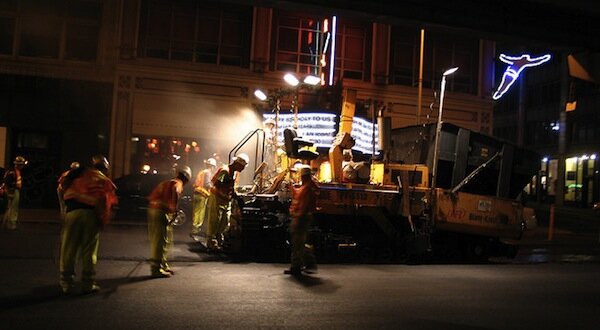 Photo of night paving project courtesy of SDOT/Allie Gerlach
Photo of night paving project courtesy of SDOT/Allie Gerlach
Look for paving crews to close the curb lane, parking lane, and bike lane on the west side of Roosevelt Way NE today and Thursday, October 13 and 14, from 9 a.m. to 3:30 p.m. The sidewalk stays open.
"As early as" Thursday, October 14, expect to see partial traffic lane closures and parking restrictions on Rainier Avenue S and S Frontenac Street, says SDOT. They're making improvements to the sidewalks and street near the southwest and northeast corners. It should take about seven to eight weeks to complete, and lane closures and parking restrictions are around-the-clock:
- Southbound curb lane closed north and south of S Frontenac Street on Rainier Avenue S
- Northbound curb lane closed north and south of S Frontenac Street on Rainier Avenue S
- Parking restricted on S Frontenac Street east and west of Rainier Avenue S
There's going to be a little touch-up work on the NE 45th Street Viaduct on Thursday, October 14, and Friday, October 15. Crews are installing a permanent railing to the north side of the viaduct, so one northbound (uphill) lane will be closed.
We also have two inspections: today, SDOT has closed the right lane southbound of the Jose Rizal Bridge (the 12th Avenue Bridge). It reopens for traffic no later than 2:30 p.m. And this weekend, both decks of the viaduct will be closed from 6 a.m. to 6 p.m., between Spokane Street and the Battery Street Tunnel.
"The average person might be surprised at how much roadway is proposed to supplement the tunnel," goes Mike Lindblom's story in the Seattle Times. But not you, the SunBreak reader, because it has always made me crazy when people argue that the tunnel's burial of SR-99 would keep cars from "choking up" the waterfront.
In a perfect world--of someone's imagining--the waterfront might be a wildflower-lined deer track, but that's never been on the table. The waterfront is already served by a multi-lane roadway for the simple reason that it's a busy area serving tourists, travelers (cruise, Clipper, and ferry), and freight, as well as Seattle residents, many of whom are already avoiding the Viaduct.
Given the tunnel's bypass of Seattle's downtown, the limits on the size and kind of freight that can use the tunnel, and the necessity of tolling to pay for the tunnel's expense, the ugly truth is, as Lindblom spells out, that projections call for the tunnel to handle 47,000 trips per day when it opens, and the waterfront boulevard to take on 35,000.* (NB: The costs for a deep-bore tunnel and a boulevard don't split along the same lines.)
From the ferry terminal south to SoDo, the boulevard would have six lanes; to the north, four; and traffic would tootle along at 30 mph.
It's counterintuitive, but in congested situations, 30 mph is faster than a limit of 50, because attempts at lane changes, exits, and entries at 50 during rush hour can easily bring everything to halt. (Of course, over one or two miles, even if you could drive at top speed, you're not saving any real time compared to 30 mph. It's a question of seconds.)...
 Photo: Staton Dubois, via our partner site Capitol Hill Seattle
Photo: Staton Dubois, via our partner site Capitol Hill Seattle
Last week's arrival of a bike box at 12th Avenue and Pine has prompted new grumblings from people who apparently can't count. (The "trapezoid" on Madison is bringing stormy denunciations as well.)
People who complain about cyclists--and correct me if I'm wrong--seem to do so because they're in a hurry. Here's a thought experiment: If we take away Seattle's three percent of bicycling commuters and add the same number of cars to the road, can you imagine what happens?
Reliably, the Seattle Times story on the event has over 100 comments, largely from people who feel that road safety should be based solely on anecdotal stories about how all cyclists run red lights or who argue that cyclists, being a strange breed of being who pay no sales, property, or gas taxes (Did you know no cyclists own cars? Not one! It's ideological) should have to pay for license and registration.
There are real concerns you can have with Seattle's growing bike infrastructure, but these aren't admissible. Some drivers flaunt traffic laws every second of every day, making other drivers crazy, but few have suggested not paying for lane striping would improve the situation. And for the record, there is no cyclist lobby pushing for red-light-running privileges; it's dangerous for everyone and the more tickets handed out for it, the better.
As for taxes...the math doesn't work the way the easily outraged seem to think. As Seattle Bike Blog notes, only the cyclist pays close to their way in taxes--car drivers pay about one-tenth the actual cost of driving in taxes and fees. If we want to start charging on a usage basis, let's start with the people who are really enjoying a socialized ride....
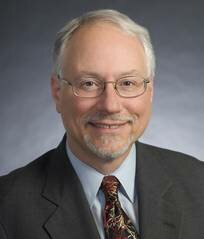 Council President Richard Conlin
Council President Richard Conlin
Yesterday at 5:38 p.m. I got an email from the City Council announcing that "Seattle City Council President confirms next phase in Alaskan Way Viaduct environmental review,"and that Council President had signed the supplemental draft environmental impact statement (SDEIS) so the city could "remain as co-lead on the [...] project."
The problem with this "git-r-done" mentality is that it doesn't follow the established process and contravenes the city charter. The official signatory for the SDEIS would be Peter Hahn, the chief of Seattle's Department of Transportation. And Hahn reports to Mayor McGinn, who had told him not to sign yet--not the Council. The City Council has no authority in the matter, an upset Mayor McGinn told The Stranger last night.
The City Council's predictably defensive email goes on to explain that the deadline for signing was yesterday, and nothing was happening:
The Director of Seattle Department of Transportation (SDOT) had a scheduled appointment with the state to complete this task. This date has been known to all parties since early July. Yesterday, the Mayor requested more time to review the SDEIS.
It may sound like the deep-bore tunnel SDEIS has been sitting around since July, but as Publicola reports, the city was given just a few days to review it and hand back:...
When Sound Transit CEO Joni Earl presented her Proposed 2011 Budget of nearly $1.1 billion to the Sound Transit Board on Thursday afternoon, she had a sobering message: Faced with a 25-percent revenue shortfall since 2008 (amounting to $3.9 billion), Sound Transit will not be able to meet all the objectives in the planned 15-year time frame for Sound Transit 2 approved by voters in 2008.
The good news is that Sound Transit's project management toolbox no longer includes hiding under the bed and waiting for bad news to go away.
"No organization can confront an expected 25 percent reduction in revenues without asking--and answering--hard questions about priorities," Sound Transit Board Chair and Snohomish County Executive Aaron Reardon was quoted as saying in a Sound Transit release. "It is important that we address these issues now and continue to move forward with expanding the region's mass transit system as rapidly as we can."
Earl outlined a series of program realignments designed to keep Sound Transit moving forward, albeit in a trimmer, adaptable way. In a PowerPoint presentation given to the board, she broke down the projects in the ST2 15-year plan into five categories: Design & Construct, Keep Moving, Retain Only Limited Funding, Suspend, and Delete....
I know, the recession is over. But here's the first line of a Seattlepi.com article this morning: "King County Executive Dow Constantine announced Tuesday morning that his proposed budget would eliminate all general fund support for human services." It would also cut ten percent of the sheriff's budget.
That's in response to the county's $60 million deficit. Seattle's projected deficit is now $67 million. The state of Washington, $520 million. Reports Bloomberg: "Washington has reduced spending by $5.1 billion in the past three years, Gregoire said last month. Yesterday, she said the state faces a deficit of almost $4.5 billion in the two-year budget cycle that begins in July." The cuts will come from social services, corrections, and community colleges.
KIRO quotes Arun Raha, the state's chief economist, saying, "In Washington, the job recovery this time around has been slower than in any of the previous four recessions. If you compound that with the fact that the hole we're in is the largest in living memory, you begin to comprehend the magnitude of the problem."
The irony, of course, is that the city, county, and state don't spend that much, proportionally, on social services to begin with. When Constantine zeroes out social services spending--sorry, battered women and anyone who has been raped--he's addressed about one-third of the problem.
But the state is pushing ahead with a plan for a larger replacement of SR 520's floating bridge--work is underway, despite there being $2 billion in funding missing from the $4.65 billion project. (How much larger? "The current SR 520 is 60 ft. wide through Foster Island in the Arboretum. The plan calls for an 133 ft. wide structure," wrote Mayor McGinn in a letter to a group protesting the new bridge's size.)...
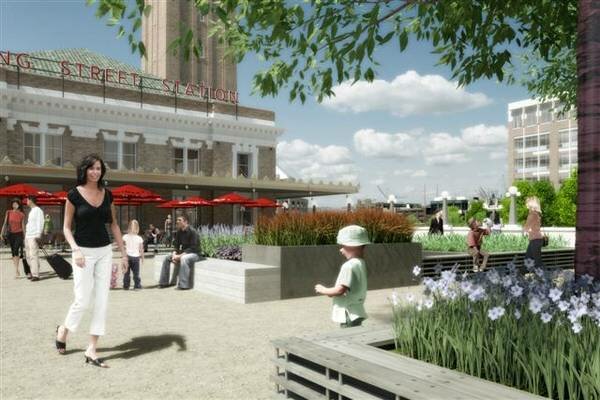 Jackson Plaza illustration courtesy SDOT
Jackson Plaza illustration courtesy SDOT
"Oh look, mommy, flowers!"
One of the amazing things about redesigned public spaces is how rarely the homeless and transient people who may already congregate in the area are seen enjoying the new look.
Here, the new Jackson Plaza, replacing a parking lot that used to sit north of the King Street Station, gains a grove of trees fronting Jackson Street and--directly in the diagonal you'd expect people to walk to and from the station entrance--a planter area.
SDOT's Brian Henry, Associate Transportation Planner, graciously sent along these visualizations when I asked about the plaza's new look, but when I asked for a rationale for the design--("Can you tell me who is designing the plaza, and would they like to explain their ideas? I have to say at first glance it seems terribly unsuited as a place for people to walk through on the way to the train.")--we seemed to lose email contact. Three weeks later I still haven't heard back....
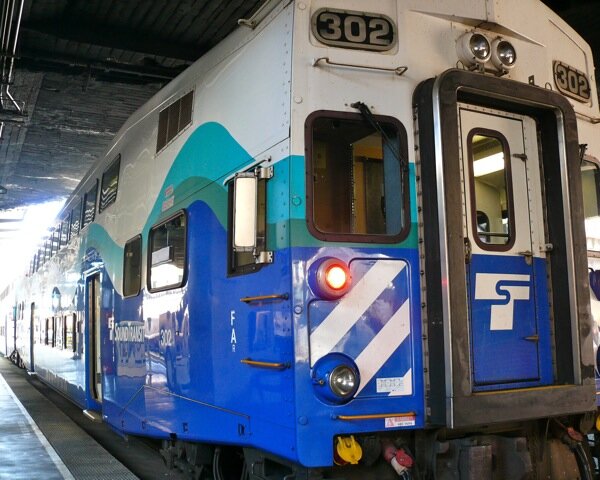 An afternoon Sounder loads up at King Street Station.
An afternoon Sounder loads up at King Street Station.
The Sounder trains from Seattle to Everett and Tacoma are largely for commuters to Seattle, which is the first thing you notice when checking out their schedules (it's an hour trip for both destinations). The bulk of the runs to Seattle are in the early morning, then back to Tacoma and Everett in the evening. And of course it's weekdays only.
You only have one or two chances to make a reverse commute, depending on where you're headed, but it is possible. If you want to spend the night is Tacoma or Everett, then everything becomes easy as pie. Either way, at just $4.50 (Everett) or $4.75 (Tacoma) each way, it's a bargain, and one that you can use your new ORCA card to pay for, if you're so inclined.
If you disembark from the last train in the evening, you may hear the engine chugging away for some time. Electro-Motive Diesel, Inc., supplies the F59PHI locomotives, and tells me that the engine is usually busy recharging batteries and otherwise transitioning from its day's work. It's self-monitoring and can shut itself off when all systems are back to "green." Even idling, these are large engines and I wondered how green they really were.
Sound Transit runs 11 of the F59PHI locomotives, which emerged from the factory with an EPA Tier 0 rating. "In 2008 we switched to a low-sulfur fuel that burns much cleaner in our locomotives than the previous fuels," says ST's Kimberly Reason. "We replaced all of our Head End Power (HEP) units with a new Tier 2 unit in 2008 as well--the HEP is the smaller engine on a locomotive that provides support electricity to the coach cars for lights, heat, AC, etc."
In 2012, Sound Transit will begin rebuilding the engines to convert to the EPA's Tier 3 rating, which requires tighter regulation of oxides of nitrogen (NOx), hydrocarbons (HC), carbon monoxide (CO), particulate matter (PM) and smoke--in the case of particulates, nitrogen oxide, and hydrocarbon, the reductions range from between 50 to 75 percent compared to Tier 0.
SDOT's blog mentions that they're painting Ts on traffic signal actuators buried in the street, so bicyclists will know where to place their front wheel for best results.
Technically, it's your bike that trips the signal, not the front wheel alone. Even a carbon fiber frame probably has enough metal on it somewhere (gears, cranks) to work. The T should help newbie cyclists especially not to ride right over the actuator, and give them confidence they won't make the fuming line of motorists behind them miss a turn cycle.
There is nothing more wonderful than cycling for looking into how in-group and out-group behaviors develop. This is one instance. When you can't, on a bicycle, get a turn signal actuator to work, you're usually stuck in the middle of traffic. Neither option available (dismounting and using the crosswalk; or making the turn anyway, when traffic permits) inspires confidence in the drivers around you, who more than likely have no idea you can't get the light to change.
Every time a cyclist doesn't appear to be obeying the rules of the road, it counts against cycling in general. This is that in-group, out-group thing I mentioned. Some of these instances have to do with learned understanding, as with this actuator example; you don't really know why a cyclist is doing what they're doing (whether it's legal or not) until you've ridden yourself....
Every so often, people who like to think of their reality as fact-based (most everyone, then) throw up their hands and ask what is to be done about people who "don't get it," as if there's some formula. This isn't a partisan viewpoint; it reflects biases we all have, which tend to show up in how we intuitively imagine consequences of action. But sometimes how we imagine builds those biases.
If you force "four busy lanes of traffic into two," after all, anyone can see that a congested crawl will be the result. In a feeble economy, it doesn't take a rocket scientist to know you need to make substantial cuts to keep the state's deficit down. If you want to save on electricity, even a child could tell you that the best thing is to turn the heat down.
Except none of that may be true.
It's based on what is easy to visualize, rather than what isn't. In the case of a road diet, the third, bi-directional turn lane gets overlooked, but left-turning cars block traffic in a four-lane model--and it gets worse the busier the street gets. So far as deficits go, consider a liquidity trap--again, harder to visualize than simply cutting to make fit. And that electric bill? "Making retrofits, for example, saves far more energy than turning down the heat a few degrees."...
Once again, if you want up-to-the-minute coverage of Seattle City Council doings, you've got to bookmark Publicola. They're looking into the Council's proposal to create a transportation benefit district (to assess a $20 annual vehicle fee for transportation improvements that SDOT's leaky budget can't handle). So far Publicola has four or five TBD posts up to...none from anyone else.
Ironically, last year the council repealed a $25 "head tax" that raised $4.5 million each year for transportation improvements, even though SDOT was already facing a deficit. Eight months later, it's time for a new tax to fill the budget hole left by the tax they repealed.
Let's begin at the very beginning: A transportation benefit district (TBD) can be set up by a city or county, creating an independent taxing district for the sole purpose of transportation funding. It can draw revenue from property, sales, and use taxes, and from annual vehicle fees. (Up to $20, vehicle fees don't require a public vote; Lake Forest Park, Edmonds, Des Moines, Olympia, Prosser, and Shoreline have already instituted the $20 yearly fee.)
The council's transportation committee chairman, Tom Rasmussen, proposed the TBD, reports Publicola, who characterize it as an "end run" around Mayor McGinn's transportation plans. In theory, this would raise $6.8 million yearly that the council would collaborate with the Mayor on disbursing....
Working my way through the draft of Washington Transportation Plan 2030, I keep coming across what looks like the future arriving today. Unfortunately, it's the future in which the state is broke, but still wants to spend billions on more roads.
"It is noteworthy that approximately 64% of current transportation funding is dependent on how much fuel cars and trucks consume," goes the report, noting at the outset that "the existing 2007-2026 WTP identifies a need to invest more than $67 billion over 20 years (2005 dollars), most of which is unfunded."
With the spike in fuel prices previously and now the recession, people have been driving less, and state revenue from the gas tax has dropped to "E" when it comes to new projects.
Today a Seattle Times headline gives you Exhibit A: "520 bridge shortfall: more tolls, taxes ahead." Even with peak driving time tolls of $3.50 each way, 520 replacement monies fall short. "The forecasts errantly assumed growth in gasoline use, which instead has gone nearly flat," says Mike Lindblom.
It's long been suspected that I-90 will need to be tolled in tandem with 520, which Seattle Senator Ed Murray is in favor of. But no one is jumping on the Coalition for a Sustainable SR 520's funding bandwagon: Their idea is to institute tolls now and a) raise money in advance while b) confirming the effects of $7 daily roundtrip tolls on traffic demand.
The same strategy could be put into effect on SR 99 (aka the Viaduct), since the state plans to toll the deep-bore tunnel as well. But so far the state seems shy about raising money in ways that might affect the rationale for spending billions on new lanes....
In the end, four of Council member Mike O'Brien's five amendments to the deep-bore tunnel resolution ended up little grave markers for political transparency. The Port can non-bindingly say it's in for $300 million. The state can stand firmly behind an unfunded transit component. It's late in the game, and it would have been profoundly surprising to find anyone with a change of heart, let alone two or three votes.
"Full speed ahead," trumpets Tim Burgess on his blog, and if you view boldface, assertion, and boldface assertion as successful rhetorical techniques, you can't help but be persuaded. (Winningly, he adds, "The issue of cost overruns has also been resolved.")
The sturm und drang over the prospect of delay on the Alaskan Way Viaduct Replacement project--the bad delay, not the good delay--aside, no one really cares what the Council thinks. It's more the principle of giving the appearance of looking after Seattle's interests. Learning that two-thirds of Seattle residents really do care how much the tunnel may finally cost, the Council went back to the drawing board to look into the benefits of punting....
It's not just light rail that people are turning to--heavy rail is growing in popularity, too. WSDOT reports that Amtrak Cascades is seeing double-digit increases in ridership compared to 2009. Second quarter of 2010 is 12 percent higher than 2009, and for the first half of 2010, ridership is up 17 percent over 2009, to almost 400,000 riders.
Explains WDOT:
A portion of the ridership growth is due to the additional service to and from Vancouver, B.C., that began in August 2009 and the 2010 Olympic Games that were held in Vancouver, B.C., in February and March.
But the Olympics alone isn't responsible for the record-breaking months of April, May, and June. The second train to Vancouver is getting use, Olympics or not. The Tacoma News Tribune quotes Vickie Sheehan, a WSDOT spokeswoman, saying, "With the economy the way it is, people are taking shorter, closer trips for their vacations."
If, as Sightline says, gas consumption has risen slightly as the price of gas has dropped, it's also true that it could clearly have risen more. (Amtrak's ridership dropped just slightly in 2009, as well.) The popularity couldn't be more timely, as the whole Cascades line is part of the planned high speed rail upgrade, which would introduce a 110-mph top speed and cut the travel time from Seattle to Portland to two and a half hours; to Vancouver, to two hours, forty-five minutes.
King County Council's Larry Phillips and Dow Constantine joined then-Seattle Mayor Greg Nickels on an inaugural Link light rail ride, one year ago.
Everyone else is doing a Link birthday post, so I am writing one, too. Link light rail is one year and six million riders old, and the enthusiasm is infectious. Mike Lindblom writes in the Seattle Times that:
Ridership has grown to an average 23,400 boardings per weekday in June, compared with 14,850 in September. Trains are noticeably more full.
At first it seemed Sound Transit would miss its 26,600 target by the end of this year, but that's now within reach.
Like the evil godmother scorned at a baby shower, the Times has been nothing short of obsessive in running down the newborn; their article on Link's opening was titled, "Light-rail trains run smoothly, if not to capacity, on first day." Their first story on passenger numbers appeared five days after Link started running. In mid-November the Times noted worriedly that:
Estimated ridership on the Seattle-Tukwila route was around 16,100 per weekday in October, showing growth but far short of the agency's near-term 26,600 target for Seattle to Sea-Tac by late 2010.
That's right. In mid-November 2009, Link ridership was "far short" of the target set for late 2010. Then ridership dipped and both the Times and Sound Politics were concerned!
Thankfully, it sounds like the white-knuckled coverage will finally be relaxing a bit. Seattle Transit Blog has been more sanguine, waiting for the public "tipping point" to be reached, but even they break out the boldface when reporting that "June represented the sixth straight month of >5% month-over-month growth."...
The tunnel's southern approach, or, "Acres of Asphalt"
This week, two consultants gave briefings on the deep-bore tunnel planned to replace the Alaskan Way Viaduct: John Newby, P.E., hired by Seattle's City Council, and Dr. Thom L. Neff, hired by Mayor McGinn (video here). Neither man said it would be easy, and neither cared to back up Gov. Gregoire's claim that there will be no cost overruns period.
But apparently it was not within the scope of their inquiry to assess how worthwhile the project is, given the risks. What is the bang for the multi-billion-dollar buck? How does this project's cost/benefit compare with other transportation projects facing the state? Crosscut wants a tunnel vote, but as much as I am dubious about the tunnel project, and despite writing about it for months, I still don't have the information needed for a baseline comparison.
Some very risky projects are worth it. Some aren't. I still maintain that Seattle's decade-long deadlock on the Viaduct's replacement simply indicates that a truly fair, useful, simple solution hasn't been arrived at--largely because leadership insists on "replacing" the Viaduct, rather than better serving the different populations who rely on it. Instead, we're offered a 1.7-mile underground bypass estimated to cost almost $2 billion before anything goes wrong.
"When things go seriously wrong with urban tunnels, the consequences can be significant, leading to long delays, large cost overruns, and extensive 3rd party damages," says Newby's report. Publicola clarifies that--just so there's no confusion--the City Council was informed that there's a 40 percent chance of cost overruns on the $1.96 billion tunnel itself, though the odds incline toward a total of not more than $2.25 billion.
Newby certainly knows firsthand the risks of tunneling; his firm CDM are geotechnical consultants on King County's plagued Brightwater sewage conveyance project. (Here they are discussing in advance how you need to have options besides rescue shafts, given the expense.) "Seattle area glacially consolidated soils have caused significant wear to TBM cutterheads and tools," his report notes. ("Significant" as in "irreparable in situ," in one case that springs to mind. Options? "As of May 1, we have no way to remove it and are still working on a plan," said King County's project manager.)...
The tunnel's southern approach, or, "Acres of Asphalt"
Yesterday City Council President Richard Conlin published an op-ed at Publicola, "State Overrun Language Serves Only to Alarm and Divide Seattleites." Mega dittos! said the Council's Tim Burgess. Apparently the two are unfazed by the prospect of bankruptcy of any kind, including intellectual.
At this point, the two have sailed deep into Glenn Beck territory, in terms of purely opportunistic argument. Forget what Conlin said before--it's different when you really want the shiny new toy.
The groupthink boosterism the two display is probably the most chilling thing to witness, since it's so pernicious to thoughtful assessment in general. When Conlin and Burgess try to characterize the replacement of the Alaskan Way Viaduct as a choice between a deep-bore tunnel or "bicycles," they sink to an embarrassing elementary-school level of disparagement.
Both men's thinking is so riddled with biased "evidence gathering" that it's hard to determine where to start in responding. There's little point in assembling a tedious list of corrections. In the long run, it doesn't matter what either of these men are "for," as regards the project. It's a state route, and the State is driving. It can only matter how well they look after Seattle's interests--and they seem to deaf to a good deal of the clamor around those.
As for "alarm" and "division," there has been no demonstrated majority in favor of a deep-bore tunnel; there is only the failure of the cut-and-cover tunnel option on a public ballot, which is neither here nor there unless you conclude that cost was a decisive factor in that tunnel's rejection. (An astute political leader might steal Mayor McGinn's "obstructionist" wind by reclaiming the fiscal conservative role, but it appears that, deep down, local leadership believe fiscal conservatism and the deep-bore tunnel to be antithetical.)...
As you know, Seattle has big plans for a streetcar network. The First Hill Streetcar (named for glancingly passing by the eastern edge of First Hill as it connects Capitol Hill and the ID) would look a little something like this. The video looks like someone was expected to watch it, which is odd because it's only available as a .wmv file on the Seattle Streetcar site. Everyone's linking to a YouTube video The Stranger made.
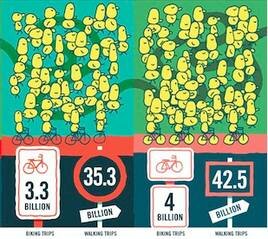 (via Fast Company) An infographic courtesy of GOOD and Part & Parcel shows how U.S. Department of Transportation spending on walking and biking has resulted in a lot more walking and biking going on.
(via Fast Company) An infographic courtesy of GOOD and Part & Parcel shows how U.S. Department of Transportation spending on walking and biking has resulted in a lot more walking and biking going on.
It seems hard to believe, but the DOT budget for bicycles and pedestrian programs in 1990 was just $6 million. By 2009, that had grown to $1.2 billion (still a laughably tiny number). But bike trips had more than doubled, from 1.7 billion trips to four, and walking trips had grown from 18 billion to 42.5.
It may seem crushingly obvious--that making it easier, or even possible, for people to walk and bike results in more walkers and bikers--but the 15-year infographic also shows the importance of sustained funding when it comes to breaking a habit like hopping in a car.
In Seattle, the $240-million Bicycle Master Plan calls for a 450-mile network of paths, lanes, and sharrows. SDOT estimates that "between 4,000 and 8,000 people bicycle commute in Seattle each day," and that, recreationally, 36 percent of Seattle bikes. As proof of the force of the "what's measured is what matters" mindset, SDOT's progress on this front is trumpeted in terms of miles implemented, rather than usage.
Given all this, you might be surprised to learn that the Northwest's gasoline consumption rose last year (both in absolute and per capita measures). Sightline's study of gas consumption notes we broke a decade-long decline of 15 percent--they chalk the increase up to lower gas prices. (Really, the big gas hogs turn out to be Idahoans; for Washington it's a slight uptick.)
Revisiting the lesson learned at the outset of this post--if you fund it, they will come--Sightline's Eric de Place and Clark Williams-Derry write with concern that:
At present, each of the Northwest’s three major metropolises is moving forward with expensive highway expansions, including a new Port Mann Bridge, east of Vancouver, BC (Can$2.4 billion), the Highway 520 floating bridge replacement between Seattle and Bellevue ($4.6 billion), and the Interstate 5 Columbia River Crossing between Vancouver, Washington and Portland ($3.2 billion)
Fascinating, isn't it? The cost of the 520 floating bridge is roughly four times the U.S. DOT expenditure on bicycling and walking programs of $1.2 billion, an amount only made possible by the "Safe, Accountable, Flexible, Efficient Transportation Equity Act: A Legacy for Users." Equity seems not, in the words of Inigo Montoya, to mean what I think it means.
People are hustling to pile up money high enough to make $131 million, which is the estimated cost to replace the South Park Bridge, a Scherzer Rolling Lift double-leaf bascule bridge, built about 80 years ago. $80 million has been allocated so far, from the state, King County, City of Seattle, and the Port. $10 million came in just four days after King County applied for it.
You'd be tempted to applaud the sight of so many political assholes and elbows shoveling dollars down South Park way, except for the fact that the bridge will "close" (in its open position) on June 30, and replacement will take at least three years. That should be just enough time to starve out any of the businesses the relied on the 20,000 vehicles the bridge carries daily.
You might wonder how a bridge that carries 20,000 vehicles a day simply arrived at the end of its lifespan with no back-up ready to put in place.
A temporary bridge was ruled out, among other reasons, because the permit process would have "taken years." This is mildly ironic because the 2001 Nisqually Quake damaged the already failing structure significantly; a Seattle P-I story said: "Officials expect to decide soon whether to replace the bridge or rehabilitate it." In 2002, the bridge received a safety rating of 4...out of 100.
Then people drove on it another eight years while officials decided to wait for someone else to pay for it....
The good news is that my phone expects the temperature to reach 78 degrees today. Let's focus on that for a moment. On Monday, the clouds should be back, and the city will be announcing budget cuts.
Friday afternoon brought another bank seizure by government regulators: Washington First International Bank was sold to Pasadena's East West Bank, reported the PSBJ. Commercial real estate gone bad. That would seem to make Jon Talton's Friday morning post about the possibility of a Seattle commercial real estate crash required reading. Goldman Sachs thinks our residential real estate is about lose 20 percent in value, so maybe put the money back into the mattress.
Lots of transportation news this week: a federal judge said "Oh hell no" to Patty Murray's attempt restore King County Metro special service to Mariners games. Metro is also gearing up for union negotiations by releasing incomplete information on bus operator compensation (and ignoring media requests for a fuller picture). And the King County Ferry District would like you not to notice that Argosy Cruises ran the West Seattle Water Taxi for cheaper....
To give you a quick sense of how the newly public operation of the King County Water Taxi (West Seattle version) is going, you have a choice: it either costs three times as much, or only $20,000 per month more, than before.
In a public/private partnership, Argosy Cruises had operated the water taxi since 1997, from spring to fall. Under Ferry District administration, West Seattle was supposed to get year-round taxi service, but now money looks very scarce. Total King County Ferry District operating costs for the Vashon and West Seattle runs for 2010 (for nine months) are pegged at around $5 million, with projections of $1 million in fares and $1 from property taxes.
Don't put too much trust in the "Privatization Saves!" faithful over at the Washington Policy Center, who are responsible for the tripled costs figure, but the fact remains that, with Argosy pocketing the fare box revenue, the public cost for the West Seattle run in 2009 was $808,000.
The contention that direct costs on the West Seattle run will be $20,000 per month more comes from Hank Meyers, the new Ferry District's executive director, who says the WPC figures are apples-to-oranges comparisons. This $20,000 increase comes despite raising the cash fare by fifty cents, to $3.50, and eliminating the $1 fare with Metro transfer. (I don't think that $20,000 includes the $7,500 in fares stolen by an employee: "As 26 (26!) of the vaults disappeared, someone finally noticed a problem," reported Seattle Weekly.)...
With King County Metro looking at a huge, hundreds-of-millions-of-dollars deficit over the next few years, everyone's donning their bean-counter hats. 70 percent of Metro's operating revenue comes from sales taxes, which have fallen off a cliff during the recession. Metro projects to bring in $700 million less than "normal" sales tax revenue between 2008 and 2013.
The solution? Cut costs and raise revenues, of course. As for the first part, it's almost time for Metro to renegotiate union contracts, and what better way to prepare the ground than to release incomplete and misleading information.
"Metro's high wage scale factors into its bus-service equation," is the headline over at helpful tool Crosscut. Author Doug McDonald, former secretary of transportation for Washington, refers to the news that Metro's top pay-rate for bus operators is among the top in the nation. (See the "More Information on Operating Program Expenses" pdf.) For perspective, what that means is that the highest salary you can make as a Metro bus driver is $59,000 per year. It's not the highest salary you can make at Metro.
According to Metro, all wages make up 44 percent of its operating costs, with benefits making up another 21 percent. Metro has one of the largest systems in the U.S., so it's not surprising that labor is a large portion--it has a fleet of 1,300 vehicles. I've asked for specifics on what the average bus operator makes, along with breakdowns of union and non-union costs. (Seattle Transit Blog was wondering the same thing and also hasn't heard back. These are basic questions, and not having the answers on hand makes you suspect obfuscation or incompetence, or both.)...
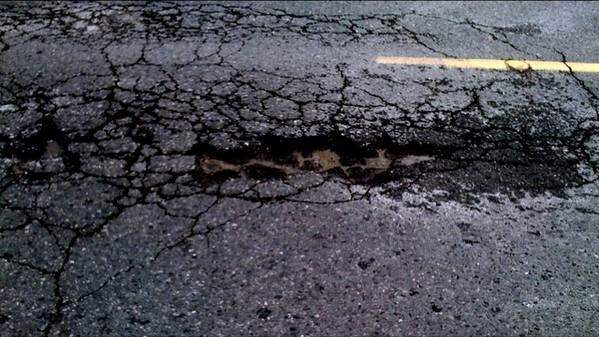 This segment is on East John St., just before Broadway.
This segment is on East John St., just before Broadway.
Last week, the Mayor and Council member Tom Rasmussen added another chapter to the endless sparring over tunnel cost overruns, and the Council's Tim Burgess announced that it was time to consider an all-out ban on plastic grocery bags. Earlier, in mid-May, the Council committed Seattle to an Arizona boycott. You wouldn't think, with all the cost overruns debate and the getting tough on panhandlers and plastic bags and Arizona, that there was anything more pressing to be done. So I have collected five photographs I'd like them to take a look at.
I have a short bicycle ride, five to ten minutes, across Capitol Hill to my office. This morning I stopped to take photos of the larger potholes on my route. (Parts of 14th Ave. E. are all potholes, but they're smaller in size.) My point is, these are photos of convenience; I didn't stop if traffic was coming, or if the pothole was on the far side of the road. Any of these, if I hit them right, might send me over the handlebars into traffic.
I don't believe the Seattle Department of Transportation is studiously ignoring Capitol Hill--everywhere I go around Seattle I see similar signs of disrepair. There is an SDOT pothole report hotline (206-684-7623, also online), but it's like playing whack-a-mole. The repairs rarely last for long. Even repaved streets don't seem to last for long, especially where there's heavy bus traffic. (I'm not blaming buses--this would suggest to me that the streets aren't being built to withstand heavy bus traffic in the first place.)
In 2006, Seattle voters passed the Bridging the Gap levy, a nine-year, $365-million transportation maintenance and improvements project specifically to catch up on deferred road maintenance. That is in addition to what is already budgeted, of course. Here is photographic evidence of just how well that's working. ...
Coverage of the tunnel project oversight meeting, attended by Governor Gregoire, the Mayor, and the City Council, provides some real whoppers. As expected, the debate grew out of the legislature's provision that Seattle property owners pay for the deep-bore tunnel project's costs if they exceed the budgeted amount of $3.1 billion.
Governor Gregoire has to take top honors for her cherry-picking defense of public project spending. The Seattle Times quotes her as saying:
"Mr. Mayor, we have a track record that's loud and clear. We have a track record of getting every project done on time and on budget," Gregoire said, specifically referring to the Tacoma Narrows Bridge and the recently finished highway ramps in Sodo.
That's right, "every project" means two projects. When the Mayor listed overruns on the Third Avenue bus tunnel, the Brightwater sewage tunnel and the Beacon Hill light-rail tunnel, the Times says Gregoire retorted, "I didn't manage those projects." She also insisted that "delay" is what causes cost overruns, a week after WSDOT announced that building an extra year into deep-bore tunnel project would actually help keep costs down.
Council member Tom Rasmussen also locked horns with the Mayor over the cost overrun provision, arguing that cost overruns are unlikely to occur because the state, planning for cost overruns, built $415 million extra into the project. Now all the cost overruns have to do is conform to projections....
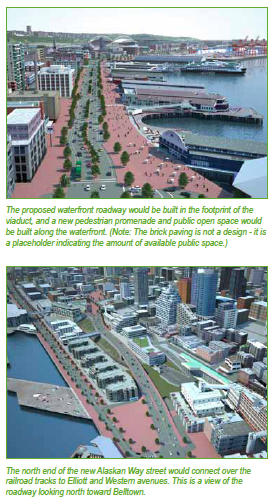
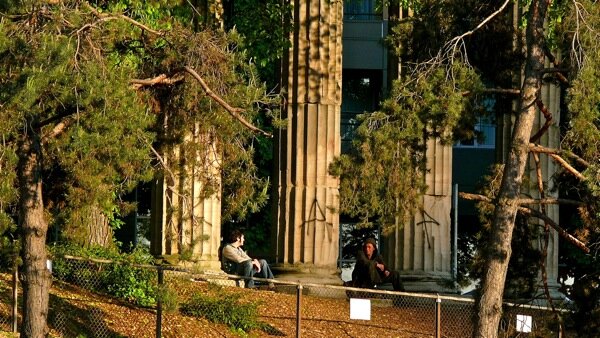
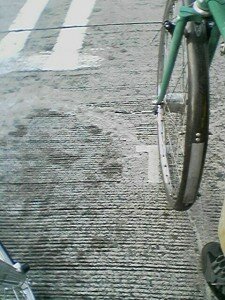
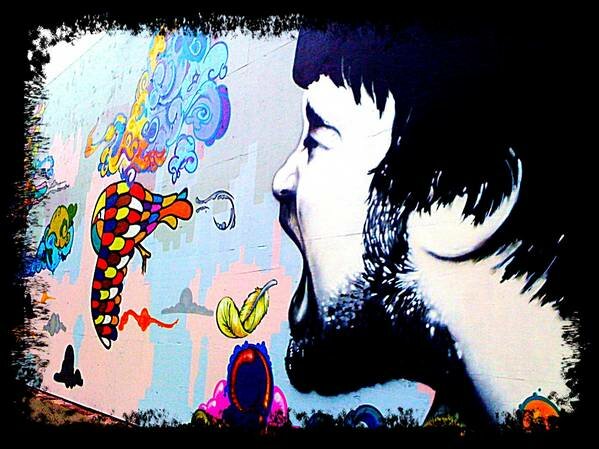

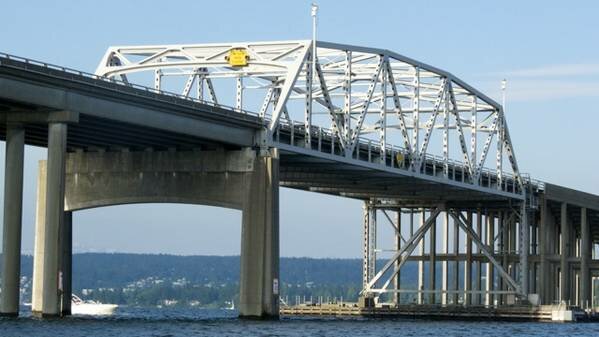
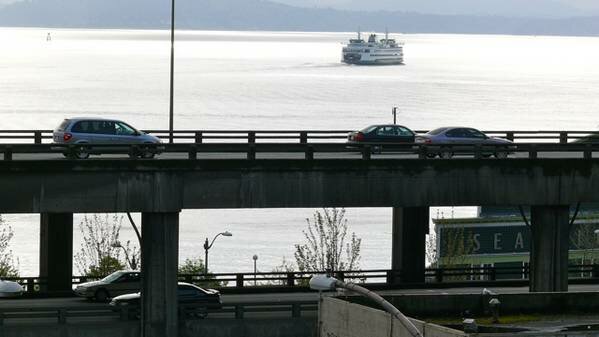
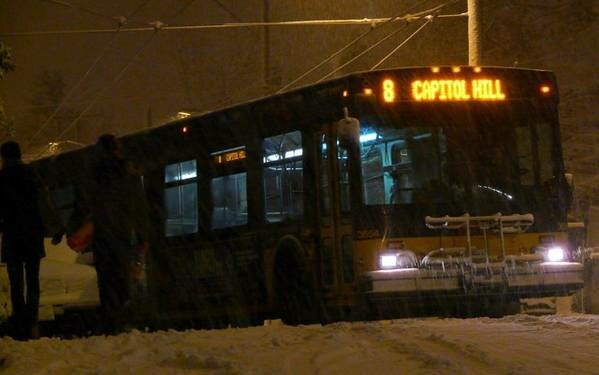

Most Recent Comments